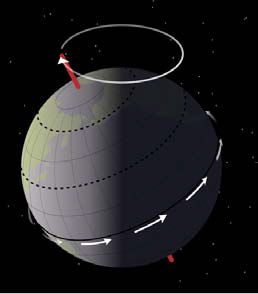Earth’s Cycles Favor Life
We all experience mood variation, to one degree or another, and that makes life interesting. But for those who experience frequent, extreme mood cycles, daily life presents major challenges. In some cases, the cycles make holding a job or maintaining close relationships virtually impossible.
Planetary scientists are discovering that what’s true about humans in this respect may also be true for planets. Orbital and rotational cycles that are too frequent, too brief, and/or too large seriously limit or eliminate a planet’s potential for life support. Research on these cycles, called Milankovitch cycles, by British geophysicist Dave Waltham adds weight to the already potent evidence for the anthropic principle—the observation that the universe manifests exquisite fine-tuning at all levels for the benefit of human existence. Because this fine-tuning occurred before humanity’s appearance, it seems the universe was intended to provide a home for humans. Waltham’s research also affirms the “rare-Earth” doctrine, which says that while planets the size and mass of Earth may prove abundant in the universe, those with all the just-right characteristics to support advanced life will prove either extremely rare or utterly unique to our solar system.1
Milankovitch cycles are recurring variations in (1) the eccentricity and inclination of a planet’s orbit; and (2) the obliquity and precession of a planet’s rotation. Eccentricity refers to the degree of elongation (or ellipticity) in a planet’s orbit, in other words, how the semi-minor axis compares with the semi-major axis (see figure 1). Inclination refers to the tilt of a planet’s orbit relative to the equator of its host star.
 |
 |
| semi-minor axis | semi-major axis |
Credit: Aliekens/Creative Commons
Figure 1: Orbital Eccentricity
No planet follows a perfectly circular orbit around its star. Elliptical orbits are the norm. The greater the difference between the semi-minor axis and the semi-major axis, the more “eccentric” is a planet’s orbit.
A planet’s obliquity refers to the angle between its rotational axis and a line perpendicular to its orbital plane. Precession refers to the gravity-induced slow, continuous circular movement of the rotation axis (such as we see in a spinning top). Notice that the rotation axis traces out a cone shape.
Figure 2: Precession of a Spinning Top
Torque created by the force of gravity applied at the center of gravity and the reactive force applied where the top touches a flat surface causes the rapidly spinning top’s rotation axis to slowly trace the circular path pictured above the top.
Earth’s precession period is about 26,000 years (see figure 3).
Credit: Robert Simmon/NASA/GSFC.
Figure 3: Precession of Earth’s Rotation Axis
The inclination of Earth’s orbit goes through its cyclical variation in about 41,000 years. The current cycle for Earth’s eccentricity variation is completed in about 100,000 years. Variation in Earth’s axial tilt is also slow and gradual, but it appears more random than cyclical, like some moods.
Earth’s obliquity varies between 22.1 and 24.5 degrees over an oscillation cycle of 41,000 years. Its current obliquity equals 23.44 degrees. Over the past four billion years, Earth’s eccentricity has varied between 0.005 and 0.058, an unusually small number. However, over the past several million years its variation has been a barely perceptible, from 0.014 to 0.019.
Waltham’s goal was to compare Earth’s cyclical periods (tens of thousands of years) and degree of orbital and rotational variation (less than a few percent) with those of other Milky Way Galaxy planets. He achieved this goal by detailed computer modeling, comparing Earth’s orbital and rotational properties with those of synthetic populations of Earth-like planets. Waltham developed three different sets of models. In the first, he varied Earth-Moon system properties and determined their effect on Earth’s obliquity variations. In the second and third, he varied the locations of individual planets in the solar system and adjusted the overall structure of the solar system to determine the effect on Earth’s eccentricity cycle.
In all three cases, Waltham proved that the actual Earth-Moon-solar system manifests unusually low Milankovitch numbers (degree and frequency of change) compared to alternative planetary systems. He established that the probability Earth would possess these very low Milankovitch frequencies by the operation of natural forces alone is less than 0.00001 (that’s 1 in 100,000). Similarly, the probability that Earth’s Milankovitch variations would be as small as they actually are is also very low. Waltham concluded, “It therefore appears that there has been anthropic selection for slow Milankovitch cycles.”2 His conclusion is based on astronomers’ awareness that slow, lowlevel Milankovitch cycles are essential to the emergence and survival of human civilization on Earth.
Without slow, low-level Milankovitch cycles, Earth not only would be unsuitable for humans, it would also fail to exhibit the stable climate conditions necessary for a wide diversity of life. As Waltham commented, “[P]lanets with Earth-like levels of biodiversity are likely to be very rare.”3
These results also have bearing on the Gaia hypothesis, which suggests all life on Earth works together to regulate the environment so as to maintain ideal conditions for life. Waltham explains that the Gaia hypothesis confuses cause and effect. Climate stability is a precondition for a complex biosphere. It is not the consequence of a complex biosphere.
Such provides yet another example of how the more astronomers learn about planetary systems, the more evidence accumulates for the supernatural, super-intelligent design of Earth and the solar system for humanity’s specific benefit.
An expanded version of this article is available here.
Endnotes
- Dave Waltham, “Testing Anthropic Selection: A Climate Change Example,” Astrobiology 11 (March 2011): 105–14.
- bid., 105.
- Ibid.





